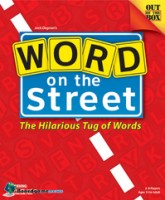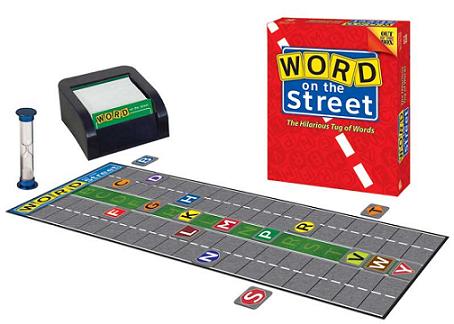
Word on the Street
2-10
12+
20+
The Hilarious Tug of Words!
On each turn, one team flips over a category card. Team members frantically brainstorm words that fit the category while the opposition tries to sidetrack them. The team must agree on a word and pull each letter of that word one lane closer to their side of the street, all before the time runs out. Word on the Street™ will have you in the fast lane to fun!

images © Out of the Box Publishing, Inc.
Publisher Video
User Reviews (4)
Add a Review for "Word on the Street"
You must be logged in to add a review.


Word on the Street is a easy yet challenging word game that is great for families and casual gamers!
The rules are fairly simply, and the game plays fairly quickly in around 30 to 45 minutes. It scales well from 2 to 10 players, since you play in teams. The goal of the game is to be the first team to capture 8 letter tiles to win the game.
PROS
Easy to learn
Team play
Don’t have to be the best speller with good teamates
Good components
CONS
Can’t think of any
GAMEPLAY
The game is straightforward by having a board that looks like a “street” with all the letters tiles laid down in the middle at the beginning. Each team takes a turn drawing a category card, and they must spell a word correctly that relates to the category. So, if the category is a “Type of Fruit”, the team could say “BANANA”. They must then proceed to spell each letter and move the correct letter that is NOT captured towards their side of the street one section at a time. So for “BANANA”, the B would be moved one section and the “N” would be moved two sections closer to the spelling team. If the letter is moved all the way off the board on your side, it is now captured and can no longer be moved by the other team. You can still use captured letters to spell words, but it just means that you don’t get to move it and makes it harder to come up with words that have letters to be moved to your favor. This all happens in single turn before the timer runs out. If the timer runs out, the team stops spelling the word and cannot finish.
It is possible that the other team can challenge the word chosen if the word is misspelled or doesn’t fit the category. If the challenge is successful, the letters are moved back to their previous position. If the challenge is unsuccessful, the challenging team loses their turn.
Strategy
There is a nice strategic aspect to the game of give and take as you not only try to capture letters for your team, but you are also trying to prevent the other team from capturing letters as well to buy your team time. The other team can also blurt out words not related to the category to throw the other team off.
Some criticism of the game is that you can learn some “goto” words that are great for this game like “grasshopper” or “baseball” that could spoil the game for experienced versus inexperienced players. I don’t think it’s a valid criticism, because these “goto” words only work for very few categories that come up and they don’t come up that often. Also, not only does the category have to come up, but the board has to be set up with the correct letters on it to really capitalize on the right letter combination which may not be there due to the letters already being captured.
Conclusion
So far, this has been a hit with my whole family that enjoys playing games. We have even had company over that has enjoyed it as well, so it has a broad appeal. I enjoy it over a game of Scrabble any day, because it’s fun and brings out the laughter more. The time limit keeps analysis paralysis in check. It’s a great way to test your kids spelling ability and help them out too, so I like the educational aspect as well.
Social gamers should really love this game, because of the team play.
Casual gamers should find it fun, since it’s easy to pick up and run with it.
Family gamers can get into it with the children that can spell.
Avid gamers should just get into it, because it’s just fun.
Power gamers and Strategy gamers should look elsewhere.
I highly recommend it.
Although I am not a big fan of word games, I find Word on the street a game of particular interest. The main reason for this is its great variety, which is lacking from several word games (and this makes them somewhat mundane to my opinion). By variety, I mean two things: First, the game’s objective is not solely focused on creating words, but also (and to a great extend) on thinking along the category that is specified by a card. This usually does not require specialized knowledge, but it challenges players to expand their scope of memory, in order to come up with as many answers as possible appropriate for the current category, within a certain amount of time. Secondly, variety is being apparent in the game through strategic aspects. That is, a word which may be a very good answer in one instance of the game, may be a weak choice at another instance. Therefore, players are required to combine their ability of quickly conjuring a wealth of words/answers appropriate, and simultaneously which makes the best choice according to how the gameboard exists at that point of the game session.
Each round is made up of a simple turn sequence, one for each of the 2 opposing teams, in order(not simultaneously), that flows in the following manner: The active team draws the next card and reads the question on it aloud. Next, the opposing team starts the time countdown, using one of the two provided hourglasses. Until the time limit elapses, the members of the active team have to come up with an appropriate word for the question on the card. They are free to exchange proposals among them, but in the end they must agree on a single word and announce it. Immediately after that decision is made, the team members manipulate the gameboard to reflect any changes brought about as a result of their having selected the particular word. To be specific, that entails moving large (and relatively heavy) squares with the letters matching the word towards their side. Meanwhile, the opposing team is responsible for supervising, although any disagreements are to be resolved after the time runs out. Then, play passes to the other team, which follows the exact same steps.
The game’s objective is to collect 8 letter squares, by consistently drawing them closer to your team’s side. Those squares all initially exist along the same lane on the gameboard, which represents a street with 5 lanes. During the game, they change lanes, according to answers given by the players, moving closer to one team or the other. Only once a square is moved off the board is considered as collected and counts towards the winning condition. Therefore, this element of moving the letter squares in a clever manner constitutes the main tactical part of Word on the street and also increases replay value because the same answers differ on how valuable they are depending on the state of a game session and the team’s plan.
Components include a gameboard, 216 cards with a tray to hold them, 2 hourglasses and the 17 letter squares (obviously not all letters of the alphabet exist), all of which are, to my opinion, of good quality and interesting design.
Although Word on the street is mostly thought of as a party game for up to 10 players (5 on each team), it can be well appreciated when played by even just 2 players. All together, it makes an intelligently designed word party game, that also appeals to a wider audience of gamers by blending tactical elements to its game play.
First off, I am not a huge fan of word games. Scrabble and Quiddler require only a knowledge of go-to words that earn you points without having to know the definition. But I am definitely a fan of this game.
COMPONENTS:
The parts that shine in this game are definitely the letter tiles themselves. They are hefty and look amazing, like they were made from gravel from the street outside. The letters that are included are only consonants and even the less popular consonants like Z and Q are removed for ease of play. The board gives plenty of room for the tiles and creates a physical barrier between the two teams. As the game goes on, the barrier becomes a war zone. There are lots of cards, but they are fairly thin. Don’t worry though, they don’t get handled that much.
GAMEPLAY:
The players are divided into 2 teams. Each team is trying to get 8 tiles onto their side. Once a tile is claimed by a team, it cannot be moved again. At the start of a team’s turn, a card is drawn that has a word category on it, like “Celebrity last name” or “Type of cake”. The team then has 30 seconds to decide on a word and spell it together, moving the appropriate tiles as they move. The opposing team can distract and debate the legitimacy of the word. A tile has to move three spots from the middle to be claimed, so you can play defensively and offensively depending on where the tiles lay.
One problem is that you can memorize words that have specific letter counts, but the chance to play those words are few and far between.
Overall, I think Jay Atkinson really nailed my feeling for this game. Great party game, really easy to learn, and it moves quickly. Enjoy!
EDIT:
I just played this game with my family over the Thanksgiving break and it was a NIGHTMARE. Please agree on a source that you can go to to resolve conflicts, or else make sure that everyone agrees to play civilly. Good luck.
The concept behind this game is simple and intelligent. You choose words based on a category and spell it out using the letters on the board. Each letter used in the word allows you to move that letter one space closer to your side. Once they are off the board, the letter is yours, and the one with the most letters wins. It’s great for building vocabulary and spelling skills. The only problem: my kids never choose to play it voluntarily. It doesn’t really grab their interest. The board is not particularly attractive, but it’s functional. The letter tiles are nice and sturdy, the cards are average. Our board is permanently bowed ever since we opened it, which doesn’t interfere with game play but is still disappointing.
If you’re into word games like Scrabble and Boggle, you’ll probably really enjoy this game.